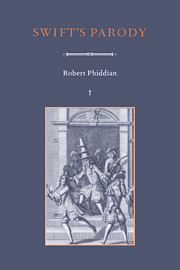Book contents
- Frontmatter
- Contents
- Acknowledgments
- List of abbreviations
- Introduction
- 1 Theoretical orientations
- 2 Restoration enterprises and their rhetorics
- 3 Parody and the play of stigma in pamphlet warfare
- 4 The problem of anarchic parody: An Argument against Abolishing Christianity
- 5 Authority and the author: the disappearing centre in Swiftian parody
- 6 Entrance to A Tale of A Tub
- 7 A Tale of A Tub as an orphaned text
- 8 A Tale of A Tub as Swift's own illegitimate issue
- Conclusion: parodic disguise and the negotiability of A Tale of A Tub
- Select bibliography
- Index
4 - The problem of anarchic parody: An Argument against Abolishing Christianity
Published online by Cambridge University Press: 29 September 2009
- Frontmatter
- Contents
- Acknowledgments
- List of abbreviations
- Introduction
- 1 Theoretical orientations
- 2 Restoration enterprises and their rhetorics
- 3 Parody and the play of stigma in pamphlet warfare
- 4 The problem of anarchic parody: An Argument against Abolishing Christianity
- 5 Authority and the author: the disappearing centre in Swiftian parody
- 6 Entrance to A Tale of A Tub
- 7 A Tale of A Tub as an orphaned text
- 8 A Tale of A Tub as Swift's own illegitimate issue
- Conclusion: parodic disguise and the negotiability of A Tale of A Tub
- Select bibliography
- Index
Summary
It is commonly assumed that parody is a sub-genre of satire, a kind of partisan diagnosis of diseases in the plausible. This view projects it as a form of rhetorical interrogation which is implicitly oppositional – it seeks to expose the absurdity of errant texts and discourses and to apportion blame. As we have seen, Defoe's Shortest Way with the Dissenters and Swift's Abstract of Collins' Discourse of Free-Thinking are functional texts in this way, aimed at identifying error and its religio-political affiliations. While a thoroughgoing investigation of the ironies can turn up more subversive implications in these texts, they operate primarily as suasive parodies: they deconstruct their victim-texts in order to persuade readers of the truth of a solution which is retrievable from the parodic text. The satirically ‘true’ meta-texts (the wisdom of toleration in the Shortest Way, and the need for intellectual and religious authority in the Abstract) can be identified by accurate interpretation of hints embedded in the errant languages being parodied. Certainly it is possible to argue that slippages into discourses altogether more subversive occur at the edges of these texts. Some readers have felt that Defoe mimics his victim so closely that he obscures the positive counter-message and becomes an imitator rather than a parodist. Similiarly, in the Abstract Swift can be accused of destabilising more than he manages to establish.
- Type
- Chapter
- Information
- Swift's Parody , pp. 76 - 94Publisher: Cambridge University PressPrint publication year: 1995

